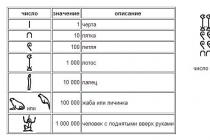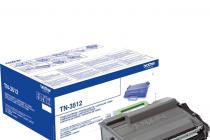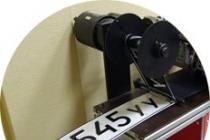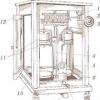Unit number system
The need to write numbers began to arise among people in ancient times after they learned to count. This is evidenced by archaeological finds in places of camps of primitive people, which date back to the Paleolithic period ($ 10 - $ 11 thousand years BC). Initially, the number of objects was depicted using certain signs: dashes, notches, circles applied to stones, wood or clay, as well as knots on ropes.
Picture 1.
Scientists call this number notation system single (unary), since the number in it is formed by the repetition of one sign, which symbolizes one.
Disadvantages of the system:
when writing a large number, you must use a large number of sticks;
it can be easy to make mistakes when applying the sticks.
Later, to make it easier to count, people began to combine these signs.
Example 1
Examples of using the unit number system can be found in our life. For example, small children try to depict on their fingers how old they are, or they use counting sticks to teach counting in first grade.
Unit system not very convenient, since the records look very long and their application is rather tedious, therefore, over time, more practical number systems began to appear.
Here are some examples.
Ancient Egyptian decimal non-positional number system
This number system appeared around 3000 BC. as a result of the fact that the inhabitants of Ancient Egypt came up with their own numerical system, in which, when denoting key numbers, $ 1 $, $ 10 $, $ 100 $, etc. hieroglyphs were used, which was convenient when writing on clay tablets, which replaced paper. Other numbers were compiled from them by addition. First, the number of the highest order was recorded, and then the lowest one. The Egyptians multiplied and divided, successively doubling the numbers. Each digit could be repeated up to $ 9 $ times. Examples of numbers for this system are given below.

Figure 2.
Roman numeral system
This system is fundamentally not much different from the previous one and has survived to this day. It is based on signs:
$ I $ (one finger) for the number $ 1 $;
$ V $ (open palm) for the number $ 5 $;
$ X $ (two palms folded) for $ 10 $;
to designate the numbers $ 100 $, $ 500 $ and $ 1000 $, the first letters of the corresponding Latin words were used ( Сentum- hundred, Demimille- half a thousand, Mille- thousand).
When compiling numbers, the Romans used the following rules:
The number is equal to the sum of the values of several identical "digits" located in a row, forming a group of the first type.
The number is equal to the difference between the values of two "digits", if to the left of the larger one is the smaller one. In this case, the smaller value is subtracted from the larger value. Together they form a group of the second kind. In this case, the left "digit" can be less than the right one by a maximum of $ 1 $ order: before $ L (50) $ and $ C (100 $) from the "minor" ones there can be only $ X (10 $), before $ D (500 $ ) and $ M (1000 $) - only $ C (100 $), before $ V (5) - I (1) $.
The number is equal to the sum of the values of the groups and "digits" that are not included in the $ 1 $ or $ 2 $ type groups.

Figure 3.
Roman numerals have been used since ancient times: they indicate dates, numbers of volumes, sections, chapters. I used to think that ordinary Arabic numerals could be easily counterfeited.
Alphabetic number systems
These number systems are more perfect. These include Greek, Slavic, Phoenician, Jewish and others. In these systems, the numbers from $ 1 $ to $ 9 $, as well as the number of tens (from $ 10 $ to $ 90 $), hundreds (from $ 100 $ to $ 900 $) were designated by letters of the alphabet.
In the ancient Greek alphabetic numeral system, the numbers $ 1, 2, ..., $ 9 were denoted by the first nine letters of the Greek alphabet, etc. The following $ 9 $ letters were used to denote the numbers $ 10, 20, ..., $ 90, and the last $ 9 $ letters were used to denote the numbers $ 100, 200, ..., 900 $.
Among the Slavic peoples, the numerical values of the letters were established in accordance with the order of the Slavic alphabet, which initially used the verb and then the Cyrillic alphabet.

Figure 4.
Remark 1
The alphabetical system was also used in ancient Russia. Until the end of the $ 17th century, $ 27 $ Cyrillic letters were used as numbers.
Non-positional number systems have a number of significant disadvantages:
There is a constant need to introduce new characters for recording large numbers.
It is not possible to represent fractional and negative numbers.
It is difficult to perform arithmetic operations, since there are no algorithms for their execution.
Non-positional number systems

People learned to count a long time ago. Subsequently, there was a need to record numbers. The number of objects was represented by drawing dashes, serifs on some hard surface. So that two people could accurately store some numerical information, they took a wooden tag, made the required number of notches on it, and then split the tag in half. Each took his half and kept it. This technique made it possible to avoid controversial situations. Archaeologists have found such records during excavations. They date back to the 10-11th millennium BC.
Scientists have named this system of noting numbers single (unary), since any number in it is formed by repeating one sign that symbolizes one.
Later, these icons began to be combined into groups of 3, 5 and 10 sticks. Therefore, more convenient number systems arose.
Around the third millennium BC, the Egyptians invented their own numerical system, in which special signs - hieroglyphs - were used to denote key numbers. Each such hieroglyph could be repeated no more than 9 times. This number system is called ancient Egyptian decimal non-positional number system
An example of a non-positional number system that has survived to this day is the number system used more than two and a half thousand years ago in Ancient Rome. It is calledroman numeral system.
It is based on the signs I (1), V (5), X (10), L (50), C (100), D (500), M (1000).
Roman numerals were used for a very long time, today they are mainly used to name significant dates, volumes, sections and chapters in books.
To write down a number, the Romans used not only addition, but also subtraction.
Rules for composing numbers in the Roman numeral system:
- Several identical digits in a row are added up (group of the first type).
- If there is a smaller one to the left of the larger digit, then the value of the smaller digit is subtracted from the value of the larger one (group of the second type).
- The values of the groups and numbers that are not included in the groups of the first and second types are added.
In the old days in Russia, number systems reminiscent of the Roman were widely used. They were called jasper... With their help, tax collectors filled out receipts for the payment of tax (yasak) and made notes in the tax notebook.
"Russian Book of Taxes"
Non-positional number systems have a number of significant disadvantages:
- There is a constant need to introduce new characters for recording large numbers.
- It is not possible to represent fractional and negative numbers.
- It is difficult to perform arithmetic operations, since there are no algorithms for their execution. In particular, all peoples, along with number systems, had methods of finger counting, and the Greeks had an abacus counting board - something like our accounts.
But we still use elements of a non-positional number system in everyday speech, in particular, we say one hundred, not ten tens, thousand, million, billion, trillion.
Numbering system (Latin numbering. Numeratio) - a method of designating numbers by means of signs - numbers, or words. The notation system based on numbers is written numbering. The word-based naming system is verbal numbering.
Number systems are divided into positional and non-positional.
The difference between positional number systems from non-positional consists in the fact that the meaning of the numbers in the positional system depends on the position in the number, and in the non-positional system it does not. Examples of positional number systems: decimal number system based on Arabic numerals; Mayan system (20-ary). Examples of non-positional number systems are Roman, Old and New Greek, Slavic.
Positional and many non-positional number systems have a so-called base. The radix also determines how numbers are divided by orders. The numbers smaller than the base are called the numbers of the first order, up to the second degree of the base (n · n) - the numbers of the second, and so on. Numbers related to the base are considered to differ by one order of magnitude.
Number systems with a base have a regular structure of names - numbers that differ by an order of magnitude are formed in a similar way. For positional number systems, the base means how many times the value of the digit will change when shifted by one position - 3 and 30 in the decimal system differ ten times. Non-positional number systems usually include signs for numbers less than the base and multiplied by an integer power of the base, for example, Roman - I = 1, V = 5, X = 10, L = 50, C = 100- the numbers I to X and to C, refer as the base of the notation system, similarly refer to V and L.
Number systems, also differing in how numbers are formed within the order. One obvious way of education is to repeat the unit symbol as many times as necessary - it is used in many ancient systems - Egyptian, Old Greek, Roman, and others. This approach allows the use of a fairly small number of different characters, but is quite wasteful. It was not uncommon in such systems to use an additional base, which is smaller than the main one. Numbers of the same order were formed similarly using an additional base. This allowed for a significant reduction in the number of repetitions. Additional bases were often 5 and 10. Thus, a separate symbol for 5 is in the old Greek and Roman numbering - Γ and V, and in the Maya 5 as an intermediate base is associated with counting on the fingers, and denoted that the fingers on the hand ended (or leg). The intermediate base 10 was used in the Old Babylonian cuneiform 60 number system.
Another method used in newer ones is using different symbols. This approach is used by the widely used decimal number system - numbers 1, 2, 3. 4, 5, 6, 7, 8, 9, 0. The same approach was used in the modern Greek and borrowed from it Old Russian. They used letters as numbers - in the new Greek it is the Greek alphabet, in the old Russian - the Cyrillic or Glagolitic alphabet, and the numerical values of the Cyrillic letters fully corresponded to those in the Greek, differed in the Glagolitic alphabet. These systems used 27 letters with meanings: from 1 to 9 through one, 10 to 90 through a dozen, 100 to 900 through a hundred.
Non-positional number systems
Non-positional number systems were historically the first to appear. In these systems, the meaning of each digital symbol is constant and does not depend on its position. The simplest case of a non-positional system is the unit one, for which a single symbol is used to denote numbers, as a rule it is a line, sometimes a dot, which is always put in the number corresponding to the denoted number:
3 - |||, etc.
Thus, this single symbol has the value of one, from which the required number is obtained by successive addition:
A modification of a unit system is a system with a base, in which there are symbols not only for designating a unit, but also for degrees of base. For example, if the base is 5, then there will be additional symbols to denote 5, 25, 125, and so on.
An example of such a base 10 system is the ancient Egyptian one, which arose in the second half of the third millennium BC. This system had the following hieroglyphs:
pole - units,
arc - tens,
palm leaf - hundreds,
lotus flower - thousands.
The numbers were obtained by simple addition, the order could be any. So, to designate, for example, the number 3815, three lotus flowers, eight palm leaves, one arc and five poles were drawn. More complex systems with additional signs - the old Greek, Roman. Roman also uses an element of the positional system - a large number in front of a smaller one is added, a smaller one in front of a larger one is subtracted: IV = 4, but VI = 6, this method, however, is used exclusively to denote the numbers 4, 9, 40, 90, 400 , 900, 4000, and their derivatives by addition.
The New Greek and Old Russian systems used 27 letters of the alphabet as numbers, where they designated each number from 1 to 9, as well as tens and hundreds. This approach made it possible to write numbers from 1 to 999 without repeating numbers.
In the old Russian system, special frames around the numbers were used to indicate large numbers.
As a verbal numbering system, non-positional is still used almost everywhere. Verbal numbering systems are strongly language-specific, and their common elements mostly relate to the general principles and names of large numbers (trillion and above). The general principles underlying modern verbal numbering involve the formation of a designation by adding and multiplying the meanings of unique names.
Positional number systems
In positional number systems, the order of numbers plays an important role. Each digit in positional notation has its own position, which determines its numerical value. The positions of the numbers are called the digits.
For positional s. with. Some natural number greater than or equal to two is chosen as a base. Any non-negative integer is represented as the sum of powers of n with integer coefficients ranging from 0 to n-1. These coefficients are written in the form of digits of the selected number system.
The general number system can be defined as a grouping of integers and fractional numbers in which each of them is represented by the formula:
in which n stands for the base of the number system, and the symbol ai - i-th digit of the number recording, ai must be in the range from 0 to n-1. The suffix next to a digit is the bit number.
In computer science and computer science, bases 2 (binary), 8 (octal), and 16 (hexadecimal) are often used. The binary number system is associated with the peculiarities of the functioning of digital electronic circuits operating with two states, expressed by the numbers 0 and 1. The use of number systems with bases 8 and 16 is due to the fact that for convenience, binary numbers are grouped by 3 and 4, respectively, which allows the use of more compact recording. In hexadecimal and other number systems with base more than ten, the letters of the Latin alphabet are used as missing digits: A - F.
The hexadecimal number system is used to encode a discrete signal, the consumer of which is a well-trained user - a specialist in the field of computer science. This form represents the contents of any file requested through the integrated shells of the operating system, for example, by means of Norton Commander in the case of MS DOS. The characters used to represent the number are decimal digits from 0 to 9 and the letters of the Latin alphabet - A, B, C, D, E, F.
The decimal number system is used to encode a discrete signal, the consumer of which is the so-called end user - a non-specialist in the field of informatics (it is obvious that any person can act as such a consumer). The characters used to represent the number are numbers from 0 to 9.
The correspondence between the first few natural numbers of all three number systems is presented in the translation table:
Decimal | Binary system | Hexadecimal system |
To distinguish the number systems in which numbers are presented, additional details are introduced into the designation of binary and hexadecimal numbers:
for binary numbers, the subscript to the right of the number in the form of the number 2 or the letters B, or b (binary), or the sign B or b to the right of the number. For example, 1010002 = 101000b = 101000B = 101000B = 101000b;
for hexadecimal numbers - the subscript to the right of the number in the form of the number 16 or letters H or h (hexadecimal - hexadecimal), or the sign H or h to the right of the number. For example, 3AB16 = 3ABH = 3ABh = 3ABH = 3ABh.
There are certain rules for translating numbers from one number system to another. They differ depending on the format of the number - whole or regular fraction. For real numbers, a combination of translation rules for whole number and regular fraction is used.
Rules and examples for converting from binary to decimal number system
There is the following sequence of zeros and ones: - 9 digits in total. It must be presented in decimal form. To convert to the decimal number system, we write from right to left 9 powers of the number 2 (from 0 to 8 degrees), everything is simple, each subsequent number is obtained by multiplying the previous one by 2:
Let's write our binary number under the powers (from left to right, as it is):
Then we find the sum of those powers of two, under which there are units:
256 + 32 + 4 + 1 = 293, this is the result of the translation:
So, let's write down the rule for converting from binary to decimal:
To convert numbers from the binary number system to decimal, we count the number of digits N and write the powers of two from zero to N - 1 from right to left (remember that each subsequent power is obtained by multiplying the previous one by 2). Let us write down a binary number under them and find the sum of the degrees under which the ones stand. The result is a decimal number, represented as the sum of the various powers of 2.
There are many ways to represent numbers. In any case, the number is represented by a symbol or a group of symbols (word) of some alphabet. Such characters are called numbers.
Number systems
To represent numbers, non-positional and positional number systems are used.
Non-positional number systems
As soon as people began to count, they had a need to write numbers. The finds of archaeologists at the sites of primitive people indicate that initially the number of objects was displayed in an equal number of any icons (tags): notches, dashes, dots. Later, for ease of counting, these icons began to be grouped in three or five. This system of writing numbers is called single (unary), since any number in it is formed by repeating one sign, symbolizing one. Echoes of the unit number system are still found today. So, in order to find out in which course a cadet of a military school is studying, you need to count how many stripes are sewn on his sleeve. Without realizing it, kids use the single number system, showing their age on their fingers, and counting sticks are used to teach 1st grade students to count. Let's consider various number systems.
The unit system is not the most convenient way to write numbers. It is tedious to record large quantities in this way, and the records themselves are very long. Over time, other, more convenient, number systems have emerged.
Ancient Egyptian decimal non-positional number system... Around the third millennium BC, the ancient Egyptians invented their own numerical system, in which the key numbers are 1, 10, 100, etc. special icons were used - hieroglyphs. All other numbers were compiled from these key ones using the addition operation. The numeral system of Ancient Egypt is decimal, but non-positional. In non-positional number systems, the quantitative equivalent of each digit does not depend on its position (place, position) in the number record. For example, to depict 3252, they drew three lotus flowers (three thousand), two folded palm leaves (two hundred), five arcs (five dozen) and two poles (two units). The size of the number did not depend on the order in which its constituent signs were located: they could be written from top to bottom, from right to left, or alternately.
Roman numeral system... An example of a non-positional system that has survived to this day is the number system that was used more than two and a half thousand years ago in Ancient Rome. The Roman numeral system was based on the signs I (one finger) for the number 1, V (open palm) for the number 5, X (two folded palms) for 10, and the first letters of the corresponding Latin words began to be used to denote the numbers 100, 500 and 1000 (Сentum - one hundred, Demimille - half a thousand, Mille - a thousand). To write down the number, the Romans decomposed it into the sum of thousands, half a thousand, hundreds, fifty, tens, heels, units. For example, decimal 28 is represented as follows:
XXVIII = 10 + 10 + 5 + 1 + 1 + 1 (two tens, heels, three units).
To write intermediate numbers, the Romans used not only addition, but also subtraction. In this case, the following rule was applied: each smaller sign placed to the right of the larger one is added to its value, and each smaller sign placed to the left of the larger one is subtracted from it. For example, IX - means 9, XI - means 11.
Decimal number 99 has the following representation:
XCIX = –10 + 100–1 + 10.
Roman numerals were used for a very long time. Even 200 years ago, in business papers, numbers had to be denoted by Roman numerals (it was believed that ordinary Arabic numerals were easy to forge). The Roman numeral system is used today mainly for naming significant dates, volumes, sections and chapters in books.
Alphabetic number systems... More perfect non-positional number systems were alphabetical systems. These number systems included Greek, Slavic, Phoenician and others. In them, numbers from 1 to 9, whole numbers of tens (from 10 to 90) and whole numbers of hundreds (from 100 to 900) were designated by letters of the alphabet. In the alphabetic numeral system of Ancient Greece, the numbers 1, 2, ..., 9 were denoted by the first nine letters of the Greek alphabet, etc. The following 9 letters were used to denote the numbers 10, 20, ..., 90, and the last 9 letters were used to denote the numbers 100, 200, ..., 900.
Among the Slavic peoples, the numerical values of the letters were established in the order of the Slavic alphabet, which used first the verb and then the Cyrillic alphabet.
In Russia, Slavic numbering was preserved until the end of the 17th century. Under Peter I, the so-called Arabic numbering prevailed, which we still use today. Slavic numbering was preserved only in liturgical books.
Non-positional number systems have a number of significant disadvantages:
- There is a constant need to introduce new characters for recording large numbers.
- It is not possible to represent fractional and negative numbers.
- It is difficult to perform arithmetic operations, since there are no algorithms for their execution.
Positional number systems
In positional number systems, the quantitative equivalent of each digit depends on its position (position) in the code (record) of the number. Nowadays we are used to using the decimal positional system - numbers are written using 10 digits. The rightmost digit denotes units, to the left - tens, even to the left - hundreds, etc.
For example: 1) sexagesimal (Ancient Babylon) - the first positional number system. Until now, when measuring time, a base equal to 60 is used (1min = 60s, 1h = 60min); 2) the duodecimal number system (the number 12 - “dozen” became widespread in the 19th century: there are two dozen hours in a day). Counting not on the fingers, but on the joints of the fingers. On each finger of the hand, except for the thumb, there are 3 joints - 12 in total; 3) currently, the most common positional number systems are decimal, binary, octal and hexadecimal (widely used in low-level programming and in general in computer documentation, since in modern computers the minimum unit of memory is an 8-bit byte, the values of which are conveniently written in two hexadecimal digits ).
In any positional system, a number can be represented as a polynomial.
Let's show how a decimal number is represented as a polynomial:
Number system types
The most important thing to know about the number system is its type: additive or multiplicative... In the first type, each digit has its own meaning, and to read the number, you need to add all the values \ u200b \ u200bof the digits used:
XXXV = 10 + 10 + 10 + 5 = 35; CCXIX = 100 + 100 + 10–1 + 10 = 219;
In the second type, each digit can have different meanings depending on its location in the number:

(hieroglyphs in order: 2, 1000, 4, 100, 2, 10, 5)
Here the hieroglyph “2” is used twice, and in each case it took different meanings “2000” and “20”.
2´ 1000 + 4´ 100 + 2´ 10 + 5 = 2425
For an additive ("supplementary") system, you need to know all the digits-symbols with their meanings (there are up to 4-5 tens of them), and the order of writing. For example, in Latin notation, if a smaller digit is written before a larger one, then subtraction is performed, and if after, then addition (IV = (5–1) = 4; VI = (5 + 1) = 6).
For a multiplicative system, you need to know the image of numbers and their meaning, as well as the base of the number system. Determining the base is very easy, you just need to recalculate the number of significant digits in the system. If simpler, then this is the number with which the second digit of the number begins. For example, we use numbers 0, 1, 2, 3, 4, 5, 6, 7, 8, 9. There are exactly 10 of them, therefore the base of our number system is also 10, and the number system is called “decimal”. In the above example, the numbers 0, 1, 2, 3, 4, 5, 6, 7, 8, 9 are used (auxiliary 10, 100, 1000, 10000, etc. do not count). There are also 10 main digits here, and the number system is decimal.
As you might guess, how many numbers there are, the same number of bases of number systems can be. But only the most convenient radixes are used. Why do you think the base of the most common human number system is 10? Yes, precisely because we have 10 fingers on our hands. “But there are only five fingers on one hand,” some will say, and they will be right. The history of mankind knows examples of five-fold number systems. “And with legs - twenty fingers” - others will say, and they will also be absolutely right. This is what the Maya Indians thought. It can even be seen from their numbers.
The notion “dozen” is very interesting. Everyone knows that it is 12, but where this number came from - very few people know. Look at your hands, or rather, at one hand. How many phalanges are there on all the fingers of one hand, not counting the thumb? That's right, twelve. And the thumb is intended to mark the counted phalanges.
And if on the other hand we put off the number of full dozens with our fingers, then we get the well-known sixties Babylonian system.
In different civilizations, they counted in different ways, but even now it is possible even in the language, in the names and images of numbers to find the remains of completely different number systems that were once used by this people.
This is how the French used to have a number system of twenty, since 80 in French sounds like “four times twenty”.
The Romans, or their predecessors, once used the fivefold system, since V is nothing more than the image of a palm with a thumb extended, and X is two of the same hands.
In matters of organizing information processing with the help of a computer, an important place is occupied by number systems, forms of data presentation and special coding of numbers.
The set of techniques for naming and writing numbers is called reckoning... Under number system is understood as a way of representing any number using a limited alphabet of characters called numbers.
All number systems can be divided into two classes: positional and non-positional.
In non-positional number systems, each number is denoted by a corresponding set of symbols. In non-positional number systems, the meaning of a symbol does not depend on the place it occupies in the number. An example of a non-positional number system is roman numeral system... This system uses 7 characters, which correspond to the following values:
I (1), V (5), X (10), l (50), c (100), d (500), m (1000).
Roman numbering clearly shows traces of the five-fold number system. In the language of the Romans (Latin), there are no traces of the five-fold system. This means that these numbers were borrowed by the Romans from another people (presumably from the Etruscans).
All integers (up to 5000) are written by repeating the above digits. Moreover, if the larger digit is in front of the smaller one, then they add up, but if the smaller one is in front of the larger one (in this case, it cannot be repeated), then the smaller one is subtracted from the larger one. In a row, the same number is put no more than three times. For example, III (3), LIX (59), DLV (555), MCMXCVIII (1998).
The disadvantage of non-positional number systems is the absence of formal rules for writing numbers and arithmetic operations on them. In computing, non-positional systems are not used.
In ancient Babylon, about 40 centuries before our time, local (positional) numbering was created, i.e. a way of displaying numbers, in which the same number can mean different numbers, depending on the place occupied by this number. Our present numbering is also local, but in Babylonian local numbering, the role that the number 10 plays with us was played by the number 60, and therefore this numbering is called sixty.
The sixty-decimal notation of integers did not become widespread outside the Assyro-Babylonian kingdom, but the sixty-decimal fractions penetrated far beyond these limits: into the countries of the Middle East, Central Asia, North Africa and Western Europe. They were widely used, especially in astronomy, up to the invention of decimal fractions. Traces of sixty fractions are preserved to this day in the division of angular and arc degrees (as well as hours) by 60 minutes and minutes by 60 seconds.
Positional number systems have great advantages in the clarity of the representation of numbers and in the ease of performing arithmetic operations. In the positional number system, the value of a number is determined not only by the set of digits included in it, but also by their place (position) in the sequence of digits representing this number. An example of a positional number system is the decimal system. In addition to decimal, there are other positional number systems; to write numbers in different number systems, a number of different characters are used. The number of such characters in the positional number system is called the base of the number system and is denoted by the letter q... The decimal system uses ten characters (numbers): 0, 1, 2, 3, 4, 5, 6, 7, 8, 9, and the base of the system is the number 10. Table 3.1 shows the names of some positional number systems and a list of numbers, from which numbers are formed in them.
Table 3.1.
|
Base |
Notation |
Symbols |
|
Binary | ||
|
Ternary | ||
|
Octal |
0, 1, 2, 3, 4, 5, 6, 7 |
|
|
Decimal |
0, 1, 2, 3, 4, 5, 6, 7, 8, 9 |
|
|
Hexadecimal |
0, 1, 2, 3, 4, 5, 6, 7, 8, 9, A, B, C, D, E, F |
A special place among positional number systems is occupied by systems with power-law weights of the digits, in which the weights of adjacent positions of digits (digits) differ in magnitude by a constant number of times equal to the base q number system.
In the general case, in such a positional number system with a radix q any number X can be represented as an expansion polynomial (the sum of the products of the coefficients by the degrees of the base of the number system):
here q- the base of the number system;  - recording a number in the base numeral system q;
- recording a number in the base numeral system q;
 - whole numbers less than q;
n- the number of digits in the integer part of the number; m- the number of digits in the fractional part of the number.
- whole numbers less than q;
n- the number of digits in the integer part of the number; m- the number of digits in the fractional part of the number.
Thus, the meaning of each character in the number depends on the position that the character occupies in the number record. That is why such number systems are called positional. For example,
In computer science, positional number systems with a non-decimal base are used: binary, octal and hexadecimal, i.e. radix  , where k= 1, 3, 4.
, where k= 1, 3, 4.
Currently, positional number systems are more widespread than non-positional ones. This is because they allow you to write large numbers with a relatively small number of characters. An even more important advantage of positional systems is the simplicity and ease of performing arithmetic operations on numbers written in these systems.
Computing machines, in principle, can be built in any number system. But the decimal system so familiar to us will turn out to be extremely inconvenient. If in mechanical computing devices using the decimal system, it is enough to simply use an element with many states (a wheel with ten teeth), then in electronic machines it would be necessary to have 10 different potentials in the circuits.
The most convenient for constructing a computer turned out to be the binary number system, i.e. a number system in which only two digits are used: 0 and 1, since from a technical point of view, it is easier to create a device with two states, and it is also easier to distinguish between these states.
To represent these states in digital systems, it is sufficient to have electronic circuits that can take on two states that are clearly distinguished by the value of any electrical quantity - potential or current. One of the values of this quantity corresponds to the number 0, to the other - 1. The relative simplicity of creating electronic circuits with two electrical states has led to the fact that the binary representation of numbers dominates in modern digital technology. In this case, 0 is usually represented by a low level of potential, and 1 - a high level. This way of presenting is called positive logic.














